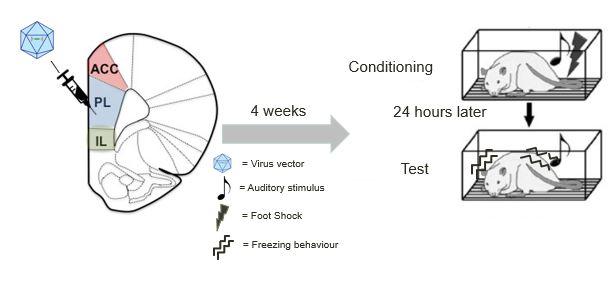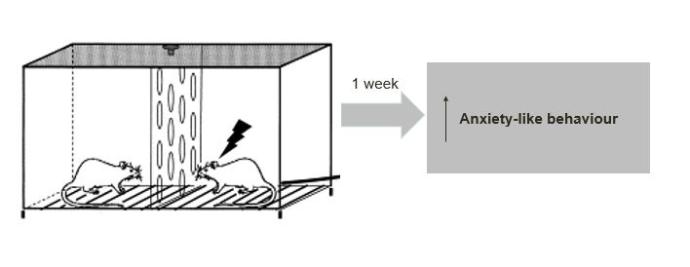Materials & Methods
Experiment 1
In order to test the effects of Prdm2, I used virus-induced knockdown to reduce the expression of this gene in the prelimbic cortex through stereotactic surgery. Briefly, I injected a recombinant adeno associated virus 9 (rAAV9) carrying a short hairpin RNA (shRNA) that specifically targets the degradation of Prdm2 mRNA in the neurons in the prelimbic cortex. We used a total of 40 animals:
- 20 animals received Prdm2 knockdown;
- 20 animals served as scrambled control (injection of an ineffective shRNA in the same region),
Following the incubation time of the virus (four weeks), I tested the effects of gene knockdown in innate anxiety levels in an elevated plus maze and open field test. After that, I exposed the animals to a cued fear conditioning paradigm, as a model of posttraumatic stress disorder. In brief, the paradigm consisted of two phases: on the first day, the animals learned to associate an aversive stimulus (foot shock) to a neutral auditory stimulus; on the second day, only auditory stimuli were presented without any foot shock; freezing behaviour during the auditory stimulation was used as a parameter of fear. Fig. 2 summarizes the experimental set up.

Experiment 2
This study represents a pilot study in order to check the best conditions for our stress model. The experiment was only carried out with male subjects because time issues did not allow a replicate with females. I used a total of 20 animals:
- 7 rats were directly exposed to the foot shocks;
- 7 rats were forced to witness the scene;
- 6 rats served as controls.
Each subject belonging to the first group was exposed to five repeated inescapable foot shocks per five consecutive days, while another individual was forced to witness the scene but without receiving any foot shock (Fig. 3). Controls were placed in the same set up for the same amount of time but no foot shocks were delivered. Following the first stress exposure all the subjects, including the controls, were socially isolated until the end of the experiment, given that social interactions could buffer stress resulting from traumatic experiences. One week after the last stress exposure, we tested anxiety-like behaviour in the three groups using standard behavioural assays, such as elevated plus maze and open field test.

Responsible for this page:
Director of undergraduate studies Biology
Last updated:
